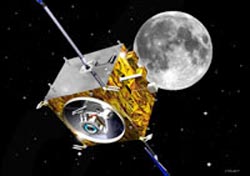Last ion engine thrust puts SMART-1 on the right track for its Moon encounter

Artist’s impression of SMART-1
From 10 to 14 October the ion engine of ESA’s SMART-1 carried out a continuous thrust manoeuvre in a last major push that will get the spacecraft to the Moon capture point on 13 November.
SMART-1, on its way to the Moon, has now covered more than 80 million kilometres. Its journey started on 27 September 2003, when the spacecraft was launched on board an Ariane 5 rocket from Europe’s spaceport in Kourou, French Guiana. Since then, it has been spiralling in progressively larger orbits around Earth, to eventually be captured by the lunar gravity and enter into orbit around the Moon in November this year.
The SMART-1 mission was designed to pursue two main objectives. The first is purely technological: to demonstrate and test a number of space techniques to be applied to future interplanetary exploration missions. The second goal is scientific, mainly dedicated to lunar science. It is the technology demonstration goal, in particular the first European flight test of a solar-powered ion engine as a spacecraft’s main propulsion system, that gave shape to the peculiar route and duration (13 months) of the SMART-1 journey to the Moon.
The long spiralling orbit around Earth, which is bringing the spacecraft closer and closer to the Moon, is needed for the ion engine to function and be tested over a distance comparable to that a spacecraft would travel during a possible interplanetary trip. The SMART-1 mission is also testing the response of a spacecraft propelled by such an engine during gravity-assisted manoeuvres. These are techniques currently used on interplanetary journeys, which make use of the gravitational pull of celestial objects (e.g. planets) for the spacecraft to gain acceleration and reach its final target while saving fuel.
In SMART-1’s case, the Moon’s gravitational pull has been exploited in three ’lunar resonance’ manoeuvres. The first two successfully took place in August and September 2004. The last resonance manoeuvre was on 12 October, during the last major ion engine thrust, which lasted nearly five days, from 10 to 14 October. Thanks to this final thrust, SMART-1 will make two more orbits around Earth without any further need to switch on the engine, apart from minor trajectory correction if needed. The same thrust will allow the spacecraft to progressively fall into the natural sphere of attraction of the Moon and start orbiting around it from 13 November, when it is 60 000 kilometres from the lunar surface.
SMART-1 will reach its first perilune (initial closest distance from the lunar surface) on 15 November, while the ion engine is performing its first and major thrust in orbit around the Moon. After that it will continue orbiting around the Moon in smaller loops until it reaches its final operational orbit (spanning between 3000 and 300 kilometres over the Moon’s poles) in mid-January 2005. From then, for six months Smart-1 will start the first comprehensive survey of key chemical elements on the lunar surface and will investigate the theory of how the Moon was formed.
Media Contact
All latest news from the category: Physics and Astronomy
This area deals with the fundamental laws and building blocks of nature and how they interact, the properties and the behavior of matter, and research into space and time and their structures.
innovations-report provides in-depth reports and articles on subjects such as astrophysics, laser technologies, nuclear, quantum, particle and solid-state physics, nanotechnologies, planetary research and findings (Mars, Venus) and developments related to the Hubble Telescope.
Newest articles

Properties of new materials for microchips
… can now be measured well. Reseachers of Delft University of Technology demonstrated measuring performance properties of ultrathin silicon membranes. Making ever smaller and more powerful chips requires new ultrathin…

Floating solar’s potential
… to support sustainable development by addressing climate, water, and energy goals holistically. A new study published this week in Nature Energy raises the potential for floating solar photovoltaics (FPV)…

Skyrmions move at record speeds
… a step towards the computing of the future. An international research team led by scientists from the CNRS1 has discovered that the magnetic nanobubbles2 known as skyrmions can be…





















